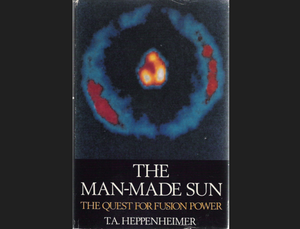Fusion in the 1980s: a behind-the-scenes look
A detailed and lively account of fusion research in the late 1970s and early 1980s, The Man-Made Sun is set against the backdrop of the looming "energy crisis" when the oil barrel, which had been stable at an average of $3 since 1946, passed the $10 mark in 1974 and was trading at $37.5 in 1980—almost one hundred of today's dollars.
Industrialized societies were facing a future with fuel that was neither "cheap" nor "convenient." Like the spectre of "peak oil" and climate change today, the oil crisis thirty years ago sparked renewed interest in non-fossil energies.
While public opinion embraced the promise of solar and wind energy and governments were considering investing massively in nuclear programs, several laboratories, largely out of the public eye, were attempting to fuse isotopes of hydrogen to ignite "the fire of the Sun" in a new generation of fusion machines.
In 1983, the year T.A. Heppenheimer's The Man-Made Sun was published, hopes for demonstrating the feasibility of fusion energy were at an all-time high. The Tokamak Fusion Test Reactor (TFTR) was nearing completion at the US Princeton Plasma Physics Laboratory, as were the European JET in the UK and JT-60 in Japan. At the Kurchatov Institute in Moscow, where the tokamak concept had been "invented" in the mid 1950s, plans were being drafted for a very large superconducting machine, T-20, that would surpass the TFTR-sized tokamaks.
The Man-Made Sun traces the development of fusion energy programs—with a strong emphasis on US labs—from the early research on mirror machines at Princeton and Livermore in the mid-1950s to the "big tokamak" programs of the early 1980s.
Heppenheimer's clear and vivid narrative provides an exceptional behind-the-scenes look at how large science projects were conducted in labs and government offices. The Man-Made Sun is a story about scientists and bureaucrats, visionaries and maverick entrepreneurs. The pages that Heppenheimer devotes to Robert Bussard's "Riggatron" and the financial backing he received from Penthouse publisher Bob Guccione are particularly colourful.
"Fusion is unquestionably one of the key technologies that will shape the coming millennium," writes Heppenheimer in the closing pages of the book. "Today we see it as a man-made sun about to rise; tomorrow, we will stand in the radiance of its bright promise." Thirty years later, tomorrow is here and—despite some delay—so is the "bright promise."
The Man-Made Sun: The Quest for Fusion Power, T. A. Heppenheimer, Little, Brown, 1983
The book is available in the ITER library, 519/15.


